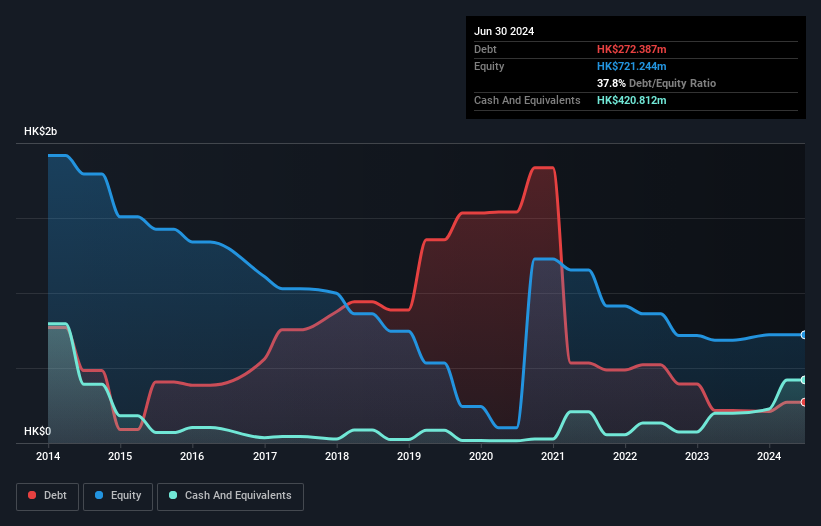- Hong Kong
- /
- Electronic Equipment and Components
- /
- SEHK:2078
Is PanAsialum Holdings (HKG:2078) Using Too Much Debt?
Warren Buffett famously said, 'Volatility is far from synonymous with risk.' So it might be obvious that you need to consider debt, when you think about how risky any given stock is, because too much debt can sink a company. As with many other companies PanAsialum Holdings Company Limited (HKG:2078) makes use of debt. But the more important question is: how much risk is that debt creating?
What Risk Does Debt Bring?
Debt is a tool to help businesses grow, but if a business is incapable of paying off its lenders, then it exists at their mercy. Ultimately, if the company can't fulfill its legal obligations to repay debt, shareholders could walk away with nothing. However, a more frequent (but still costly) occurrence is where a company must issue shares at bargain-basement prices, permanently diluting shareholders, just to shore up its balance sheet. Of course, the upside of debt is that it often represents cheap capital, especially when it replaces dilution in a company with the ability to reinvest at high rates of return. The first thing to do when considering how much debt a business uses is to look at its cash and debt together.
View our latest analysis for PanAsialum Holdings
How Much Debt Does PanAsialum Holdings Carry?
You can click the graphic below for the historical numbers, but it shows that as of June 2024 PanAsialum Holdings had HK$272.4m of debt, an increase on HK$217.4m, over one year. But it also has HK$420.8m in cash to offset that, meaning it has HK$148.4m net cash.

How Strong Is PanAsialum Holdings' Balance Sheet?
According to the last reported balance sheet, PanAsialum Holdings had liabilities of HK$681.8m due within 12 months, and liabilities of HK$51.4m due beyond 12 months. Offsetting this, it had HK$420.8m in cash and HK$161.8m in receivables that were due within 12 months. So its liabilities total HK$150.6m more than the combination of its cash and short-term receivables.
Given this deficit is actually higher than the company's market capitalization of HK$134.4m, we think shareholders really should watch PanAsialum Holdings's debt levels, like a parent watching their child ride a bike for the first time. Hypothetically, extremely heavy dilution would be required if the company were forced to pay down its liabilities by raising capital at the current share price. Given that PanAsialum Holdings has more cash than debt, we're pretty confident it can handle its debt, despite the fact that it has a lot of liabilities in total. The balance sheet is clearly the area to focus on when you are analysing debt. But you can't view debt in total isolation; since PanAsialum Holdings will need earnings to service that debt. So if you're keen to discover more about its earnings, it might be worth checking out this graph of its long term earnings trend.
Over 12 months, PanAsialum Holdings made a loss at the EBIT level, and saw its revenue drop to HK$992m, which is a fall of 11%. We would much prefer see growth.
So How Risky Is PanAsialum Holdings?
Although PanAsialum Holdings had an earnings before interest and tax (EBIT) loss over the last twelve months, it made a statutory profit of HK$32m. So taking that on face value, and considering the cash, we don't think its very risky in the near term. We're not impressed by its revenue growth, so until we see some positive sustainable EBIT, we consider the stock to be high risk. The balance sheet is clearly the area to focus on when you are analysing debt. However, not all investment risk resides within the balance sheet - far from it. Case in point: We've spotted 3 warning signs for PanAsialum Holdings you should be aware of, and 1 of them shouldn't be ignored.
At the end of the day, it's often better to focus on companies that are free from net debt. You can access our special list of such companies (all with a track record of profit growth). It's free.
New: Manage All Your Stock Portfolios in One Place
We've created the ultimate portfolio companion for stock investors, and it's free.
• Connect an unlimited number of Portfolios and see your total in one currency
• Be alerted to new Warning Signs or Risks via email or mobile
• Track the Fair Value of your stocks
Have feedback on this article? Concerned about the content? Get in touch with us directly. Alternatively, email editorial-team (at) simplywallst.com.
This article by Simply Wall St is general in nature. We provide commentary based on historical data and analyst forecasts only using an unbiased methodology and our articles are not intended to be financial advice. It does not constitute a recommendation to buy or sell any stock, and does not take account of your objectives, or your financial situation. We aim to bring you long-term focused analysis driven by fundamental data. Note that our analysis may not factor in the latest price-sensitive company announcements or qualitative material. Simply Wall St has no position in any stocks mentioned.
About SEHK:2078
PanAsialum Holdings
An investment holding company, manufactures and trades in aluminum products in the People's Republic of China, Australia, South East Asia, and internationally.
Adequate balance sheet and slightly overvalued.
Market Insights
Community Narratives



